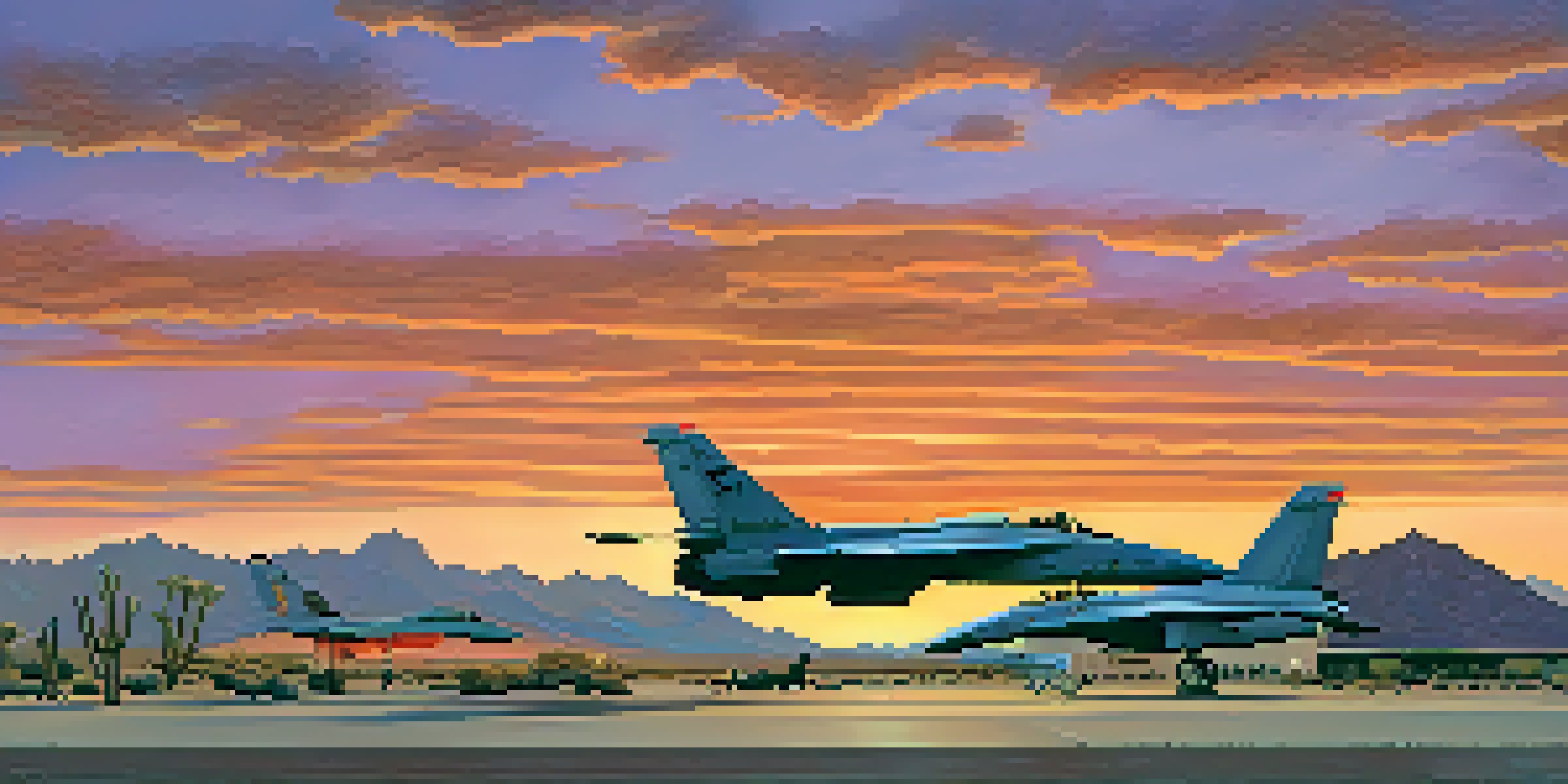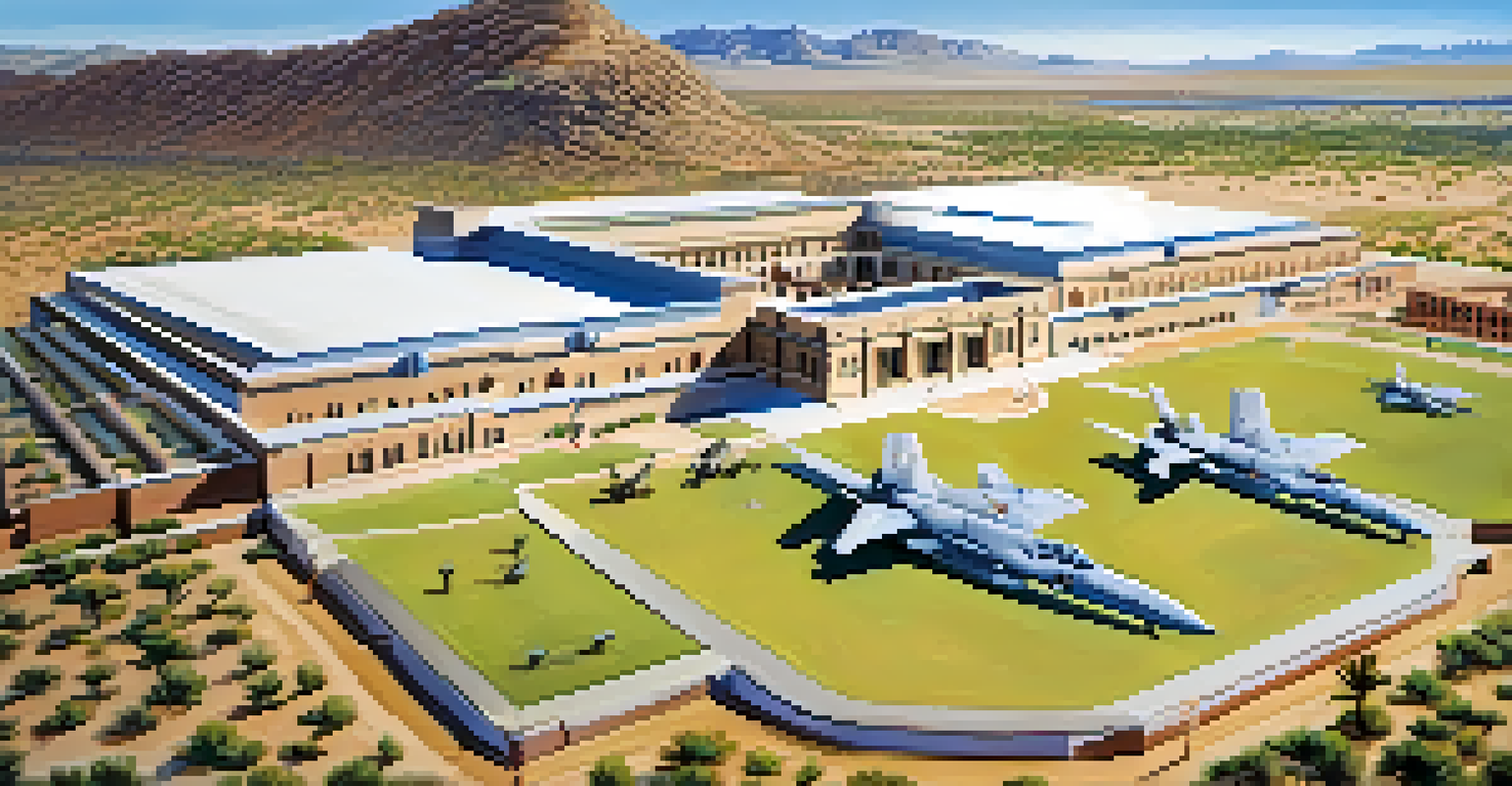Major Military Bases in Tucson and Their Historical Significance

Introduction to Tucson's Military Heritage
Tucson, Arizona, is not just known for its stunning desert landscapes; it's also home to several significant military bases. These installations have played crucial roles in the defense strategies of the United States and have become integral parts of the local community. Understanding their history can provide valuable insights into both military operations and local culture.
The soldier is the Army. No army is better than its soldiers.
From the days of World War II to present-day operations, these bases have evolved in response to changing military needs and technologies. They serve not only as training grounds but also as hubs for innovation in defense. Furthermore, the presence of these bases has fostered a unique relationship between the military and the city, influencing everything from local economy to social dynamics.
In this article, we’ll explore some of the major military bases in Tucson, delving into their historical significance and the impact they've made on the region. Let’s embark on this journey through time, uncovering stories of bravery, innovation, and community.
Davis-Monthan Air Force Base: A Historical Overview
Davis-Monthan Air Force Base (DM) is perhaps the most notable military installation in Tucson. Established in 1925, it has a rich history that reflects the evolution of air power in the U.S. military. Originally a training facility, it played a vital role during World War II and has since become a key site for air combat operations.

The base is home to the 355th Wing, which conducts a variety of missions, including combat support and training. Additionally, the boneyard, or Aerospace Maintenance and Regeneration Group (AMARG), is located here, where retired aircraft are stored and preserved. This unique aspect of DM highlights the base's significance not just in active military operations but also in preserving aviation history.
Tucson's Military Heritage Matters
Tucson's military bases have a deep-rooted history that significantly influences the local culture and economy.
Davis-Monthan remains a cornerstone of Tucson’s military presence and continues to contribute to national defense strategies. Its legacy is a testament to the city’s long-standing connection with the air force and its vital role in the broader context of American military operations.
Fort Huachuca: A Center for Military Intelligence
Located about 75 miles southeast of Tucson, Fort Huachuca has been a vital military installation since its establishment in 1877. Originally used as a frontier outpost, it has transformed into a premier center for military intelligence training. It is particularly known for its role in developing advanced communication and reconnaissance techniques.
Military power wins battles, but spiritual power wins wars.
The fort has been instrumental during various conflicts, including World War II and the Cold War, adapting to the evolving needs of the military. Today, it houses the U.S. Army Intelligence Center, where soldiers receive training in critical skills necessary for modern warfare. This focus on intelligence highlights the growing importance of information in military operations.
Fort Huachuca's contributions extend beyond the military; it also plays a role in the local economy and community. Its presence has led to the development of infrastructure and services that benefit both military personnel and civilians alike, further intertwining the base with the fabric of Southern Arizona.
The Role of Marine Corps Air Station Yuma
Though not technically in Tucson, Marine Corps Air Station (MCAS) Yuma is a significant military base impacting the region. Established in 1959, it has become one of the busiest air stations in the Marine Corps, specializing in training and operational support. Its location allows for extensive training exercises in various environments, essential for preparing marines for deployment.
MCAS Yuma is home to several squadrons, and its training facilities cater to a wide range of aviation operations. The base has played a crucial role in the development and testing of advanced military aircraft, making it a key player in national defense. Its operations not only bolster military readiness but also enhance technological advancements in aviation.
Training Facilities Enhance Readiness
The various military training facilities in Tucson play a crucial role in preparing service members for their missions.
The economic impact of MCAS Yuma is felt throughout the region, with numerous jobs linked to the base's operations. Additionally, community events and partnerships foster a strong relationship between the base and Tucson, highlighting the importance of military presence in local culture and economy.
Military Training Facilities in Tucson
Tucson is home to several military training facilities that support various branches of the armed forces. These facilities provide essential training resources for personnel, ensuring they are well-prepared for their missions. From combat simulations to advanced medical training, Tucson's military infrastructure plays a vital role in national security.
One notable facility is the Silverbell Army Heliport, which offers a unique training environment for aviators. Additionally, the Tucson-area desert serves as a natural training ground, allowing military units to conduct realistic exercises in challenging conditions. This combination of facilities and environments enhances the effectiveness of military training programs.
The presence of these training centers also benefits the local economy, creating jobs and driving business opportunities. Moreover, they foster a sense of pride within the community, as residents recognize the importance of supporting those who serve in the armed forces.
The Community Impact of Military Bases
Military bases in Tucson have a profound impact on the local community, shaping both the economy and social landscape. With thousands of service members and their families residing in the area, the bases contribute significantly to local businesses and services. Restaurants, shops, and schools often cater to the needs of military families, creating a diverse and vibrant community.
Additionally, military installations often engage in community outreach programs, fostering strong relationships with local organizations. These initiatives can range from educational partnerships to volunteer efforts, allowing service members to give back to the community that supports them. This engagement not only benefits the military but also enriches the lives of Tucson residents.
Community Ties Strengthen Support
The relationship between military bases and the Tucson community fosters economic growth and social engagement.
The presence of military bases also brings a sense of honor and respect for those who serve. Local events, such as parades and memorial services, often highlight the contributions of the armed forces, reinforcing the community's commitment to supporting service members and their families.
Challenges Faced by Military Bases in Tucson
While Tucson’s military bases have many benefits, they also face significant challenges. Budget cuts and shifting military priorities can lead to reduced funding and resources, impacting training and operations. This can create uncertainty for service members and their families, as they navigate changes within the military structure.
Environmental concerns are also at the forefront, as bases work to balance military operations with sustainability initiatives. Issues such as water usage, land management, and wildlife conservation are increasingly important as communities and military installations seek to coexist harmoniously. Addressing these challenges requires collaboration and innovation from both military and local stakeholders.

Despite these hurdles, Tucson’s military bases continue to adapt and thrive. They demonstrate resilience in the face of adversity, ensuring that they remain vital components of national defense while contributing positively to the community.
Conclusion: The Legacy of Tucson’s Military Bases
In conclusion, the military bases in Tucson have played a significant role in shaping both local history and national defense strategies. Their rich legacies are woven into the very fabric of the community, influencing everything from economic development to social dynamics. By understanding these installations' historical significance, we gain a deeper appreciation for the sacrifices and contributions of service members.
As we look to the future, the ongoing relationship between Tucson and its military bases will continue to evolve. The commitment to supporting the armed forces and fostering community ties will remain paramount, ensuring that both the military and local residents thrive together.
Ultimately, Tucson's military bases stand as a testament to the enduring spirit of service and sacrifice. Their stories remind us of the importance of honoring those who protect our freedoms while recognizing the impact they have on the communities they serve.